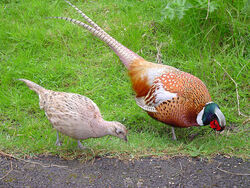Assessment |
Biopsychology |
Comparative |
Cognitive |
Developmental |
Language |
Individual differences |
Personality |
Philosophy |
Social |
Methods |
Statistics |
Clinical |
Educational |
Industrial |
Professional items |
World psychology |
Biological: Behavioural genetics · Evolutionary psychology · Neuroanatomy · Neurochemistry · Neuroendocrinology · Neuroscience · Psychoneuroimmunology · Physiological Psychology · Psychopharmacology (Index, Outline)

Female (left) and male Common Pheasant, illustrating the dramatic difference in both color and size between the sexes
Sexual dimorphism is the systematic difference in form between individuals of different sex in the same species.
Examples of sexual dimorphism[]
In some species, including many mammals, the male is larger than the female. In others, such as some spiders and birds, and many insect species, the female is larger than the male. Other sex-specific differences include color (most birds), size or presence of parts of the body used in struggles for dominance, such as horns, antlers, and tusks; size of the eyes (bees); possession of stings (various kinds of bees), and different thresholds for certain behaviors (aggression, infant care, etc.).
Sexual dimorphism is particularly apparent in game bird species such as the pheasant. Male pheasants are notably larger than females and possess bright plumage; females are usually a drab brown. Some cases of sexual dimorphism in birds are so striking that males and females of a same species were originally taken to be members of entirely different species, as in the case of the Eclectus Parrot (Eclectus roratus), where the male is predominantly green with an orange beak and the female mainly scarlet with a black beak.
Certain sexual dimorphism have obvious utility (beyond mate attraction) such as the case of the Blue Wildebeest. The horns of the male are much larger, allowing the male to engage in combat more effectively as he competes with other bucks for mating privileges. He also uses the horns aggressively to mutilate trees, a dual functionality of enhancing his grazing forage and attracting the female with this athletic display.
The Huia (Heteralocha acutirostris), a New Zealand bird species that became extinct around 1903, was another striking example of sexual dimorphism. The male's bill was short, sharp and stout while the female's was long, thin and crescent shaped. This beak dimorphism allowed mated pairs of Huia to feed cooperatively; the male chiseled the entrance to beetle grub holes in living trees, whereupon the female probed inside the enlarged hole to pull out the grub. Other purposes of these birds' dimorphism had yet to be ascertained by the time Huia went extinct.
One of the most extreme examples of sexual dimorphism is found in small worms of the genus Osedax, which live on whale falls. The females feed on whale bones. The males live inside the females and do not develop past their larval stage except to produce large amounts of sperm.
Some species of Anglerfish also display extreme sexual dimorphism. Females are the more recognized "representatives" of the species with illicium for bait, while males are small larvae fish with no digestive systems. The males must find a female and fuse with it and live off her body while producing sperm.
Sexual dimorphism in humans[]

Stylised illustration of humans on the Pioneer plaque, showing sexual dimorphism.
Sexual dimorphism in humans is the subject of much controversy, especially relating to mental ability and psychological gender. (For a discussion, see sex and intelligence, gender, and transgender.)
There is also sexual dimorphism in the amount and distribution of body hair, with males having more terminal hair, especially on the face, chest, abdomen and back, and females having more vellus hair, which is less visible. This may also be linked to neoteny in humans, as vellus hair is a juvenile characteristic.
Human male and female appearances are perceived as different, although Homo sapiens has a low level of sexual dimorphism compared with other species. For instance, the relative similarity in the sizes of many male and female human beings suggests that divisions for homo sapiens are less clear than other species as the overlap of sizes between the two sexes is slightly less than 1 standard deviation. The Centers for Disease Control and Prevention published new American curves in 2000. [1] See also intersex.
The body masses of both male and female humans are approximately normally distributed. In the United States, the mean mass of an adult male is 78.5 kg (173.1 lb), that of the adult female mean is 62.0 kg (136.7 lb). The standard deviation of male body mass is 12.6 kg (27.8 lb), so 10% of adult males are lighter than the average female.
Some biologists theorise that a species' degree of sexual dimorphism is inversely related to the degree of paternal investment in parenting. Species with the highest sexual dimorphism, such as the pheasant, tend to be those species in which the care and raising of offspring is done only by the mother, with no involvement of the father (low degree of paternal investment). Conversely, the low level of sexual dimorphism in humans is said to correlate to the human species' high degree of paternal investment (fathers make a high investment in childrearing).
Biological aspects of sexual dimorphism[]
Initially, sexual dimorphism would seem to place the organism at a disadvantage. For instance, the bright colouration of male game birds makes them highly visible targets for predators, while the drably coloured females are far better equipped to camouflage themselves. Likewise, the antlers of deer and other forms of natural weaponry are very expensive to grow and carry in terms of the energy consumed by the animal in the process.
The answer to this apparent paradox is that, at a biological level, the reproductive success of an organism is often more important than duration of life. This is particularly apparent in the case of game birds: a male Common Pheasant in the wild often lives no more than 10 months, with females living twice as long. However, a male pheasant's ability to reproduce depends not on how long he lives but whether females will select him to be their mate. His bright colouration demonstrates to the female that he is fit, healthy and a good choice to father her chicks. (See also Handicap principle)
In the case of herd animals such as deer, a male deer's reproductive success is directly proportional to the number of sexually receptive females with which he can mate. The males' antlers are an example of a sexually dimorphic weapon with which the males fight each other to establish breeding rights. Again, although they are expensive in terms of personal survival, they ensure that the largest and strongest males will be the most successful in reproducing and thereby ensure that those characteristics are passed on to the next generation.
Access to the opposite sex is not the only reason why sexual dimorphism exists. In insects in particular, females are often larger than the males. It is thought that the reason lies in the huge number of eggs that insects lay; a larger body size enables a female insect to lay more eggs. In some cases, sexual dimorphism enables males and females to exploit different food resources, thus increasing their collective ability to find food. Some species of woodpecker have differently-sized and shaped beaks, enabling the sexes to find insects in different layers of a tree's bark.
Sexual dimorphism is sometimes quantified by biologists through the dimorphism index, which is usually the ratio between the average adult male mass and average adult female mass (see for a thorough review sexual dimorphism measures). For some species mass is inconvenient to measure, so a similar parameter such as volume is used instead. This index is commonly written as the abbreviation "SSDI", for "sexual size dimorphism index". Species that are typically polygynous tend to have high SSDI ratios, while species that are typically polyandrous tend to have low ratios.
Sexual dimorphism is regarded as a classic example of genetic polymorphism, though its underlying mechanism varies in different organisms. It is often controlled by genes on the sexual chromosomes.
See also[]
- Bateman's principle
- Digit ratio
- Sexual selection
- Sexual differentiation
- Sexually dimorphic nucleus
- Sexual dimorphism measures
- Gender differences
bg:Полов диморфизъм de:Sexualdimorphismus es:Dimorfismo sexual fr:Dimorphisme sexuel lt:Lytinis dimorfizmas nl:Seksueel dimorfisme pt:Dimorfismo sexual ru:Половой диморфизм sk:Sexuálny dimorfizmus sv:Könsdimorfism
| This page uses Creative Commons Licensed content from Wikipedia (view authors). |